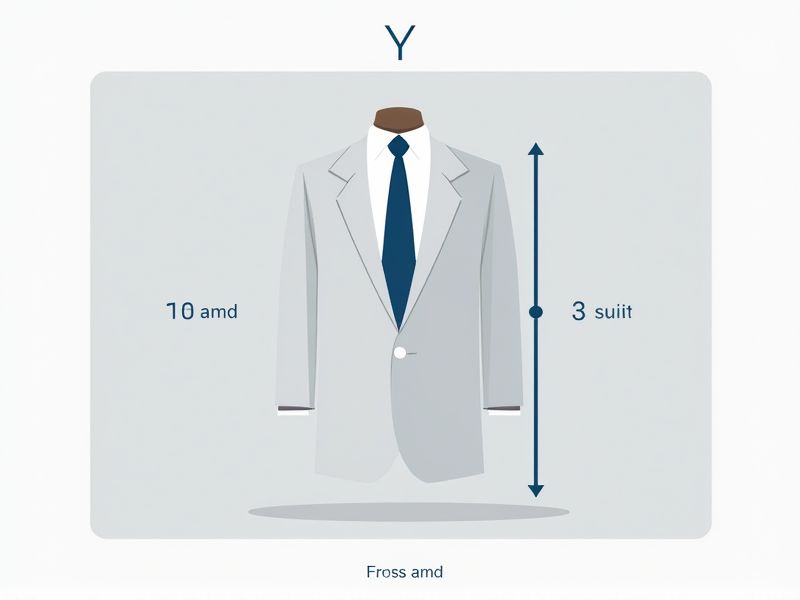
Understanding the standard dimensions of a suit can help you select a garment that fits well and looks professional. Typically, men's suits are sized by chest measurement (in inches) and jacket length, such as 40R for a 40-inch chest in a regular length. Trousers usually have a 6-inch drop from the jacket size, so a 40R suit often comes with 34-inch waist trousers. Knowing your chest, waist, and inseam measurements, along with preferred fit (slim, regular, or classic), ensures you get a suit that's both comfortable and flattering.
Chest Measurement
When selecting a suit, the chest measurement is a critical factor, typically ranging from 36 to 54 inches for standard sizes. Accurate chest size ensures a well-fitted suit, enhancing both comfort and appearance. Tailoring adjustments can accommodate variations in body shape, allowing for a perfect silhouette. Remember, a well-fitted suit not only boosts your confidence but also reflects your personal style and professionalism.
Waist Measurement
The standard suit size primarily emphasizes the waist measurement, which typically ranges from 28 to 42 inches for off-the-rack options. Custom suits allow for even more precise waist measurements, accommodating sizes beyond the standard range. Keeping the waist well-fitted ensures a tailored appearance, enhancing your overall silhouette. Accurate waist measurements are crucial, as they directly impact comfort and mobility in the suit.
Hip Measurement
When selecting a suit, the hip measurement plays a crucial role in ensuring a perfect fit. Typically, the hip size is taken around the widest part of your hips and is vital for tailored trousers or jackets. For men, an ideal hip measurement often ranges from 36 to 44 inches, while women's suits may cater to sizes from 34 to 42 inches. Accurate hip measurements ensure that your suit not only looks sharp but also provides comfort and mobility throughout the day.
Shoulder Width
Shoulder width is crucial in determining the perfect fit for your suit, as it ensures proper proportion and comfort. A well-fitted suit jacket accommodates a shoulder width typically ranging from 16 to 20 inches, depending on body type. This measurement not only influences the overall silhouette but also affects how the fabric drapes and moves with your body. An ideal shoulder fit should allow for natural arm movement without restricting mobility, providing both style and ease for the wearer.
Sleeve Length
A well-fitted suit should ensure that sleeve length is tailored to perfection, typically 1/4 to 1/2 inch of shirt cuff visible beyond the jacket sleeve. For men, standard sleeve lengths generally range from 32 to 37 inches, while women often require between 30 to 34 inches, depending on body proportion. Your perfect sleeve length enhances overall appearance and allows for comfortable movement, contributing to a polished, professional look. Remember, adjustments can be made by a skilled tailor to achieve the ideal fit, ensuring you present your best self on any occasion.
Jacket Length
The standard jacket length for a suit typically ranges from 28 to 30 inches for shorter individuals, while taller individuals often require lengths between 30 to 34 inches. A properly fitting jacket should cover your seat and allow for unrestricted movement, ensuring comfort and style. The three main styles of jacket length include regular, short, and long, corresponding with specific height ranges--short for individuals under 5'7", regular for those between 5'7" and 6', and long for 6'1" and taller. When shopping for a suit, measuring your body from the nape of your neck to the desired jacket length is essential for achieving the perfect fit.
Trouser Waist
The standard measurement for trouser waist sizes typically ranges from 28 to 42 inches, catering to various body types. Most brands market trousers using this waist measurement, indicating where the waistband sits on the body. Accurately measuring your waist is essential for optimal fit, as it should be taken at the natural waistline, above the hips. A well-fitting trouser waist enhances overall comfort and silhouette, ensuring a polished appearance.
Trouser Inseam
When selecting a suit, the trouser inseam is crucial for achieving a polished look. Typically, a standard trouser inseam ranges from 30 to 34 inches, depending on your height and body type. A well-fitted inseam should allow for a slight break at the ankle, providing comfort without excess fabric. To ensure the perfect fit, consider having your trousers tailored, as personal measurements can vary significantly.
Trouser Rise
Trouser rise refers to the measurement from the waistband to the crotch seam, playing a crucial role in ensuring a flattering fit for various body types. Standard trouser rises typically range from 8 to 12 inches, with high-rise styles sitting above the natural waistline, while low-rise trousers sit closer to the hips. Understanding your ideal rise can enhance comfort and style, especially for occasions like business meetings or formal events. You can choose between various fits, including slim, straight, or relaxed, to complement your body shape and personal aesthetic.
Armhole Depth
Armhole depth is a critical measurement in suit design, determining how comfortably the garment fits around the arm and shoulder region. An optimal armhole depth allows for unrestricted movement while ensuring a tailored appearance. Generally, a standard armhole depth for men's suits ranges between 7.5 to 9 inches, depending on the suit size and style preference. For women, this measurement typically falls between 8 to 10 inches, emphasizing the importance of personalized fitting to enhance overall comfort and aesthetics.
